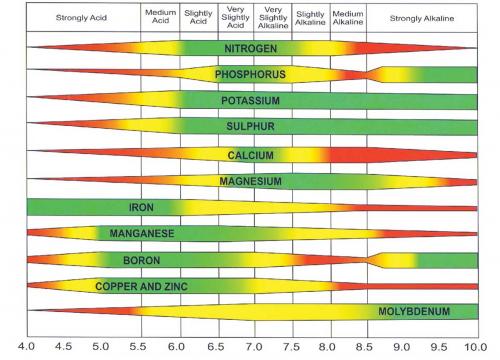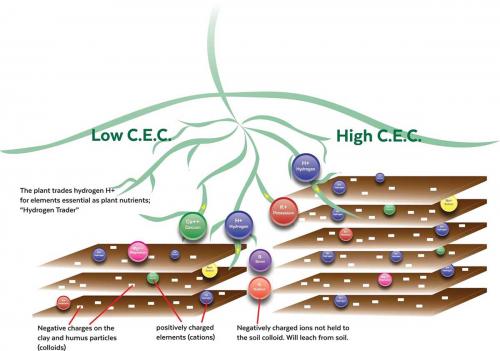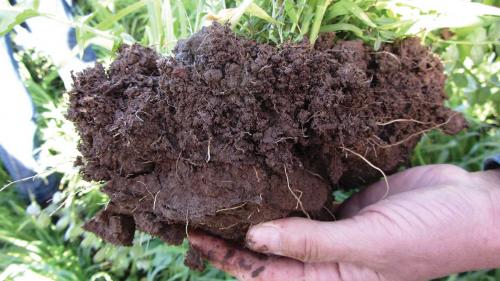Soil is an important natural and economic resource. The Australian fresh food sector is a key driver of public health, the economy and employment. The gross value of production from Australia’s 135 000 farmers is about $60 billion a year, with exports accounting for approximately $48 billion a year. Most of this agricultural production is derived from land-based broadacre farming. About 1.6 million people (one in seven Australian jobs) are in the farm-dependent economy, and food and beverage processing employs around one-third of all Australian manufacturing workers. Australian farmers own and manage 48% of Australia’s land area.
Soil and food security
Australia’s diverse soils and climate provide a wide variety of fresh food year round, and the country produces enough food to feed more than 80 million people. Historically, we produce far more than we consume, and we sell about 65% of farm production overseas, making Australia a leading food-exporting nation. We contribute to the food security not just of Australia, but also of many other nations, including our neighbours.
Sustainable soil management practices are integral to food security and thus human health.
Soil chemistry underpins sustainable agricultural production
Chemical reactions in soil control the cycling and bioavailability of nutrients. Many of the chemical elements essential to humans come from the soil through either plant or animal products. In several countries, including Australia, large proportions of the arable soils are deficient in essential elements such as zinc, iodine and selenium. Some components of soil, such as arsenic, can be taken up by plants and passed on (sometimes at toxic levels) to those who consume them.
Soil chemical reactions play an important role in the purification processes of water. Rainwater and wastewater (e.g. storm water) sources that enter the soil recharge the groundwater reserves, which are then used as a source of drinking water or for irrigation. Some of these water sources are contaminated with pollutants such as heavy metal(loid)s, pesticide residues and organic contaminants (e.g. petroleum hydrocarbons). Fortunately, soils are great water purifiers, and they represent the largest natural filter on the planet. These filtration benefits are an important part of the ecosystem services provided by soil.
Soil particles such as clay, silt and sand carry positive and negative charges. A number of physical and chemical properties of soil are controlled by the nature and the amount of surface charge and the variation of surface charge with soil solution characteristics and pH. These properties include dispersion and flocculation, electrophoretic mobility, solubility and the adsorption and movement of solutes.
Surface charge is an important determinant of the physical and chemical properties of soils, including cation exchange capacity. Surface charge can be manipulated to take advantage of solid phase interactions relating to the movement of nutrient and pollutant ions in soils, the degradation of pesticides and the decontamination of soils.
The electrical charge properties of soil colloids cover a spectrum of behaviour. At one end of the spectrum, the charge on the surface is fixed or permanent and remains independent of the solution composition, but the electric potential is sensitive to concentration of indifferent electrolyte (one that has little effect on electric potential). This is usually termed the constant charge surface or permanent surface charge. At the other end of the spectrum of the constant potential surface, it is the charge that varies with changing concentration of indifferent electrolyte. This charge is known as variable surface charge. Permanent charges are developed by isomorphous substitution of ions in the lattice structures of silicate clay minerals, whereas variable charges are developed through the dissociation of functional groups. Organic surfaces, such as humified organic matter, acquire their charge through the ionisation of carboxylic (COOH), phenolic (OH) and possibly other functional groups.
An understanding of soil in relation to plants, water and surface charge properties is critical for management systems to maintain soil chemical fertility and biophysical health for productivity, and minimise environmental degradation.
CRC for High Performance Soils
We know more about the movement of celestial bodies than about the soil underfoot.
(Leonardo Da Vinci, 1452–1519)
Despite recent major advances in understanding, the spatial and temporal heterogeneous characteristics of soil remain a mystery. The University of Newcastle is hosting the newly established Cooperative Research Centre for High Performance Soils (Soil CRC, www.soilcrc.com.au). The Soil CRC brings together 39 partners spanning the industry, government, research, not-for-profit and business sectors to help bridge the gap between soil science and farm management. The investment of $40 million from the Australian Government is being supported by more than $120 million of cash and in-kind contributions from industry and other partners over ten years. The Soil CRC will address critical barriers to high-performance soils by developing real solutions, with a focus on how these solutions could be adopted throughout the farming community. Aimed at overcoming the most complex soil management issues, the Soil CRC will integrate research across diverse fields, including soil science (including soil chemistry), big data, sensor technology, nanotechnology, environmental science, social sciences and agricultural and farm management.
In relation to chemistry, the Soil CRC aims to develop novel technologies to recover nutrients from waste and natural resources, polymer-based novel products to mitigate soil constraints, including soil acidity and sodicity, and real-time chemical sensors to monitor soil health (e.g. nutrient status). One of the major research areas for the new Soil CRC in relation to soil chemistry is nutrient recovery and synthesis of new fertiliser products. Recent research approaches have focused on nutrient ‘recovery’ from waste streams through a variety of pathways based on biological, chemical or physical processes. The primary objective of these nutrient-stripping approaches is to achieve a safe disposal of waste stream, and limited work has been carried out on the technological development for ‘recovery’ and subsequent reuse of these valuable nutrients. In order to achieve the recovery of nutrients, these options need to exhibit a unique balance between economic feasibility (effort required to make the value-added product), societal benefit (product utilisation by end-users) and ecosystem service (plant uptake, biodiversity, soil and water quality).
A number of challenges are involved in the cost-effective recovery and reuse of nutrients from waste streams. These include: (i) variability in the quantity and characteristics of various nutrients present in a range of waste streams; (ii) the low concentration of nutrients and the presence of co-contaminants – serving as technical and economic barriers for the recovery of nutrients; and (iii) uncoupling of waste generation from agricultural production, resulting in limited access at the farmgate level. The aim is to develop innovative pathways and technologies for the recovery of nutrients from waste streams and propagate the adaptive capacity required for a resource-efficient future aimed at farm profitability and food security.







